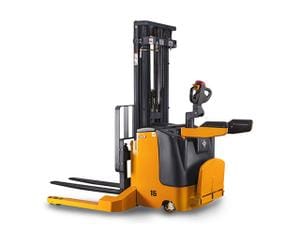Walkie Stacker Forklifts vs Regular Forklifts
Posted by: admin on November 24, 2022

Walkie Stacker Forklift
A walkie stacker forklift is a walk-behind pallet truck that features a mast for lifting pallets. It represents an excellent choice in tight workspaces where a standard lift won’t fit.
Walkie stacker safety is key, regardless of where workers use this type of lift. With OSHA-approved certification training, you can ensure your workers can properly use a walkie stacker. You can also educate your workers about all aspects of walkie stacker operation and maintenance.
What Is a Walkie Stacker Forklift?
A walkie stacker forklift is commonly used to transport pallets over short distances. In addition, a walk-behind pallet truck can provide a viable alternative in work areas where a traditional forklift is too big.
Some walkie stackers require an operator to walk behind the machine. With these stackers, an operator stands behind the unit while he or she transports a loaded pallet.
There are also ride-on walkie stacker forklifts. To use a ride-on stacker, an operator stands directly on the machine while he or transports a load.
Businesses use walkie stackers to move products onto pallets. Walkie stackers can also be used to transport heavy loads throughout a warehouse storage facility.
How Does a Walkie Stacker Work?
Walkie stackers can be manual or powered. And how they are operated varies accordingly.
To use a manual walkie stacker, an operator must push the machine on their own. The stacker has a foot pedal or handle, so an operator can raise its forks as needed. Meanwhile, there is a separate trigger that the operator can press to release pressure and lower the forks.
Powered walkie stackers require gas or electricity. They tend to offer greater load capacities than manual units.
To raise and lower the forks of a powered walkie stacker, a driver can press down on a button. The driver can move the lift forward or backward via controls on the unit’s handles.
Reading a walkie stacker forklift operating manual is crucial. This ensures an operator has instructions that he or she can follow to drive the machine safely.
Furthermore, OSHA-compliant forklift certification training can deliver long-lasting benefits for any businesses that require workers to use walkie stackers. The training teaches workers about forklift safety hazards and similar topics. It also gives workers into the different types of forklifts and how to correctly operate and maintain these machines.
Walkie Stackers vs Forklifts
Walkie stackers and forklifts are both industrial vehicles that are used to move materials around a warehouse or factory. A walkie stacker is a smaller, more maneuverable vehicle that is typically operated by one person. A forklift, on the other hand, is a larger vehicle that requires two people to operate – one to drive and one to control the forks. In terms of operation, a walkie stacker is much simpler to use than a forklift. The driver does not need to be trained, and the controls are easy to learn. However, forklifts are much more powerful and can lift heavier loads. They also have the advantage of being able to move in reverse, which can be useful in tight spaces. When deciding which type of vehicle to use, it is important to consider the specific needs of your application. If you need to move heavy loads or need the versatility of a reverse gear, then a forklift is the best option. If you need a smaller, more maneuverable vehicle, then a walkie stacker is the best choice.
Types of Walkie Stackers
Walkie stacker lifts come in a variety of models, each with its own set of features and benefits. One of the most popular types is the forklift walkie, which is equipped with forks that can be raised or lowered to load and unload materials. These lifts are typically used in warehouses and factories, where they are able to move large quantities of heavy products. Another popular type of walkie stacker lift is the stacker training, which is designed to provide operators with the skills and knowledge necessary to safely and effectively use the lift. These units are often used in conjunction with other lifting equipment, such as forklifts, to provide a complete training solution. Lastly, the walkie forklift is a specialized type of lift that is specifically designed for transporting long loads of materials. These units are commonly used in construction applications, where they can move scaffolding, lumber, and other materials from one location to another.
There are five types of walkie stacker forklifts:
1. Walkie Straddle Stacker
Walkie straddle stackers feature straddle legs that ensure load weight is distributed evenly. The legs straddle a pallet and ensure that the stacker can move close to a pallet, even in tight spaces.
2. Walkie Reach Stacker
A walkie reach stacker features a pantographic scissor mast that an operator can use to move loads forward. As such, the stacker is often used for loading trailers, trucks, and utility vehicles.
3. Ride-On Walkie Stacker
A lift operator can ride directly on a ride-on walkie stacker. Meanwhile, the stacker features controls that allow the operator to use the machine to lift and carry loads.
4. Counter-Balance Walkie Stacker
A counter-balance walkie stacker forklift has a counter-balance weight to distribute loads. It is intended for use in narrow spaces.
5. Standard Walkie Stacker Forklift
A standard walkie stacker has legs that are located beneath the lift’s forks. The legs distribute load weight and ensure that an operator can lift one or two pallets at the same time. Walkie stacker forklifts are manual or powered. Manual walkie stackers tend to have limited lifting heights and are less efficient than their powered counterparts.
Applications of Walkie Stackers
Unlike a traditional forklift, a stacker has a smaller footprint and is therefore more maneuverable in tight spaces. As a result, stackers are often used in applications where space is limited, such as in warehouses and distribution centers. In addition to their smaller size, stackers also have the ability to stack materials on top of each other. This makes them ideal for applications where high-density storage is required, such as in retail stores. Stackers can also be equipped with various attachments, such as pallet jacks and reach trucks, which further expands their potential uses. For example, a pallet jack attachment can be used to move heavy pallets of goods, while a reach truck attachment can be used to retrieve items from high shelves. Although they are typically used in industrial and commercial settings, walkie stackers can also be found in some homes. For example, some homeowners use them to move large pieces of furniture or appliances. Others use them to store larger items in tight spaces, such as in attics or basements. Regardless of their application, walkie stackers are an essential tool for many businesses and homeowners.
Benefits of a Walkie Stacker Forklift
Key reasons why businesses use walkie stackers include:
- Walkie stacker operators do not require a license. Although there is no certification required to operate a walkie stacker, all operators must learn how to safely control the forklift before use.
- Walkie stackers offer affordability. The total cost of ownership of a walkie stacker can be lower than that of a traditional forklift.
- Walkie stackers are easy to maneuver in tight spaces. Walkie stackers offer greater maneuverability in tight areas than traditional forklifts.
For businesses that are considering walkie stackers and other types of forklifts, it helps to assess all available options. This ensures that companies can identify which type of lift can deliver maximum return on investment.
Which Is Better: A Walkie Stacker or a Traditional Forklift?
A walkie stacker forklift is usually a great option in store rooms or small warehouses. A walk-behind pallet truck is generally used indoors, due to the fact that its wheels are small and not intended for use on rough terrain.
Walkie stackers tend to be less bulky than standard lifts as well. Since walkie stackers have a compact chassis, they are simple to operate. And operators can maintain full visibility of their walkie stacker, load, and surroundings any time they use this machine.
Comparatively, a traditional forklift is designed for use indoors and outdoors and can lift light and heavy loads. The lift can be used at construction sites, warehouses, and other industrial work environments.
Forklifts are terrific options for businesses that need workers to lift heavy loads. At the same time, they can be difficult to use. But OSHA-approved training is available to help workers of all skill and experience levels learn how to properly utilize a forklift.
Want to Teach Your Workers Walkie Stacker Safety?
Offer OSHA-Approved Certification Training from CertifyMe.net!
When it comes to operating a walkie stacker or any other type of forklift, it usually helps to err on the side of caution. Because, if forklift operators prioritize safety, they can take the necessary steps to avoid lift accidents.
At CertifyMe.net, we offer a comprehensive forklift safety training program for lift operators of all skill and experience levels. Our program allows workers to earn OSHA forklift safety certification in as little as one hour, and it ensures that forklift operators can properly use a lift day after day. To find out more, please contact us online or call us today at 1-888-699-4800.
Welcome to CertifyMe.net
CertifyMe.net has offered online forklift certification since 1999. With Our Convenient online program. your employess can earn their certification in an hour or less.
Browse Online Certifications:
This low-cost program can be compeleted anytime, anywhere!






